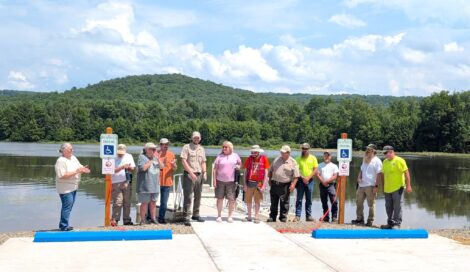Peak viewing for Perseids meteor shower this week

Chart courtesy of Martz-Kohl Observatory This chart shows approximately where the meteors of the Perseids meteor shower will originate shortly after midnight Thursday, Aug. 12.
When chunks of space debris burn up in Earth’s atmosphere, observers in the right places at the right times can sometimes see them.
“Meteors or shooting stars are particles of space debris that become vaporized in our atmosphere,” Tom Traub of the Martz-Kohl Observatory said. “Most particles are small bits of comet material released by the sun vaporizing the frozen gases or ices they were trapped in. These particles orbit the sun in the same orbit as their parent comet. Should a comet’s orbit come close to or intersect the orbital path taken by the earth these particles may well one day come into the earth’s atmosphere.”
It happens all the time.
Sometimes, as during a meteor shower, people get some warning about a good time to be watching.
The Perseids meteor shower is underway and will peak soon, according to Andy Felong, also of the Martz-Kohl Observatory. “According to NASA, this is the best shower of the year.”
“The Perseids grace the night sky with an incredible number of meteors, which are the bright streaks of light caused by bits of comet debris burning up in the atmosphere,” Felong said. “The shower, at its peak, could have more than 100 visible meteors per hour.”
Peak viewing will be very early morning Thursday, Aug. 12 — midnight to 4 a.m. — assuming skies are clear.
“Because of the earth’s orbital direction and rotation you will always see more meteors in the hours after midnight till before sunrise since this is when we plow into the meteor stream,” Traub said. “Meteors before midnight are usually catching up to the earth.”
“For the Perseids, you will want to have as clear an opening to the the sky as possible,” he said. “You will also want to get away from as much city lights or lighted areas as possible. Light pollution will drastically reduce your chances of seeing most of the fainter meteors reducing your rate from around 80 meteors per hour to about 30 instead.”
The Perseids will be coming out of the northeast — particularly the constellation Perseus.
Traub advises against looking right at Perseus to see meteors. “Since the point in the sky where the meteors seem to radiate from is in the northeast you will want to be looking about 45 degrees away from this point … almost overhead.” he said. “The reason why is the meteors will be traveling almost perpendicular to you leaving longer streaks whereas looking at the radiant they are coming almost at you leaving very short streaks.”
Those who are thinking about spending more than a few moments watching meteors should take steps to make sure they are comfortable.
“Since it’s going to be later at night, I suggest you wear warm clothes, have a blanket, and keep up with the bug spray,” Traub said. “I would suggest a nice reclining lawn chair so you won’t get a stiff neck looking up.”
Watching a meteor shower is a low-tech event. “The best way to observe meteors is with your naked eye,” Traub said. “Use of binoculars or telescopes will reduce the area of the sky you are looking at and you will miss most.”




